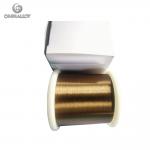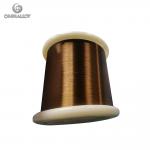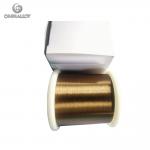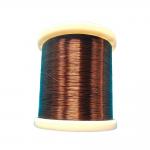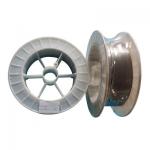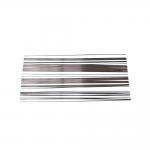OhmAlloy109
(Common Name: Ni80Cr20,Nikrothal 8,MWS-650,NiCrA,Tophet A,HAI-NiCr 80,Chromel
A,Alloy A,Alloy 650,N8,Resistohm 80, Stablohm 650,Nichorme
V,Nikrothal 80.)
Nichrome has a silvery gray coloration. Nichrome wires are quite oxidation resistant. When at a high temperature environment, up to 1200 C (Nicr 8020),
both nickle oxide and chromium oxide will be formed. As chromium
oxide is more stable than nickel oxide, a layer of chromium oxide
will be formed on the surface of the nichrome wire. The diffusion
rate D of oxygen through chromium oxide is very low, which is 10-14
cm2/sec. In order to have enough resistance, mental conduct wires always are
designed into thin form. They process of oxidation will be quick,
making them brittle and break when heated in air. By contrast, not
only does nichrome have a excellent oxidation resistant, it also
has a good ductility after high temperature use. Besides that, nichrome alloys have a higher emissivity compared to other air-stable resistance alloys. Nichrome alloys
will endure a lower element temperature at the same surface load.
Moreover, Nichrome alloys will be preferred in low-temperature
applications because of its non-magnetic feature. It also has a higher hot and creep strength, wet corrosion resistance and good wear resistance.
A marked increase in electrical resistivity is observed with
increasing chromium additions. An addition level of 20% chromium is
considered the optimum for electrical resistance wires suitable for
heating elements. This composition combines good electrical
properties with good strength and ductility, making it suitable for
wire drawing.
Application Examples
Nichrome is used to prepare bridgewire for electric ignition systems like model rocket igniters, electric matches and electronic
cigarettes.
Nichrome wires are used to test the flame color in the
non-illuminated parts of cation fire from the cations of sodium,
copper, potassium and calcium.
Nichrome is also used in microbiological laboratories.
This substance is used in the manufacturing of motorcycle silencers.
Normal composition%
| C | P | S | Mn | Si | Cr | Ni | Al | Fe | Other |
| Max |
| 0.03 | 0.02 | 0.015 | 0.60 | 0.75~1.60 | 20.0~23.0 | Bal. | Max 0.50 | Max 1.0 | - |
Typical Mechanical properties(1.0mm)
| Yield strength | Tensile Strength | Elongation |
| Mpa | Mpa | % |
| 420 | 810 | 30 |
Typical Physical properties
| Density (g/cm3) | 8.4 |
| Electrical resistivity at 20℃(Ωmm2/m) | 1.09 |
| Conductivity coefficient at 20℃ (WmK) | 15 |
| Coefficient of thermal expansion |
| Temperature | Coefficient of Thermal Expansion x10-6/℃ |
| 20 ℃- 1000℃ | 18 |
| Specific heat capacity |
| Temperature | 20℃ |
| J/gK | 0.46 |
| Melting point (℃) | 1400 |
| Max continuous operating temperature in air (℃) | 1200 |
| Magnetic properties | non-magnetic |
| Temperature Factors Of Electrical Resistivity |
| 20℃ | 100℃ | 200℃ | 300℃ | 400℃ | 600℃ |
| 1 | 1.006 | 1.012 | 1.018 | 1.025 | 1.018 |
| 700℃ | 800℃ | 900℃ | 1000℃ | 1100℃ | 1300℃ |
| 1.01 | 1.008 | 1.01 | 1.014 | 1.021 | - |
Style of supply
| Alloys Name | Type | Dimension |
| OhmAlloy109W | Wire | D=0.03mm~8mm |
| OhmAlloy109R | Ribbon | W=0.4~40 | T=0.03~2.9mm |
| OhmAlloy109S | Strip | W=8~250mm | T=0.1~3.0 |
| OhmAlloy109F | Foil | W=6~120mm | T=0.003~0.1 |
| OhmAlloy109B | Bar | Dia=8~100mm | L=50~1000 |
